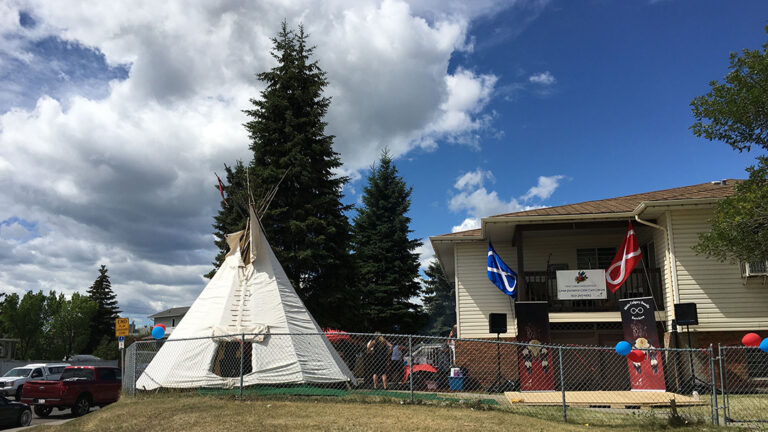The Indigenous Caucus of the Canadian Housing and Renewal Association has been busy in recent months. In November, it proposed a For Indigenous, By Indigenous strategy to address community-housing challenges. The strategy, they say, is “a turning point for the 87% of Indigenous households living in urban, rural and northern areas.” Taking advantage of the opportunities offered by the CHRA virtual conference in April, the Caucus is inviting the public to get involved in promoting the strategy or learn more about it to help advance the Reconciliation cause.
The Reconciliation movement in Canada is gaining more and more momentum these days, especially in the community-housing sector. Highlight speakers at the Canadian Housing and Renewal Association’s April 27-29 virtual Congress on Housing and Homelessness include well-known Indigenous voices such as Métis-Cree author Jesse Thistle, whose memoir, From the Ashes, put a human face on Indigenous homelessness, and Sheila Watt-Cloutier, an environmental activist who has spoken extensively about the effects of climate change on Inuit communities.
The Indigenous Caucus, which meets the day before the congress, will offer during the event innovation forum segments where topics such as building on partnerships and strategies for resilience in affordable housing will be explored. The event comes on the heels of a busy few months for the CHRA’s Indigenous Caucus. In November, they launched a “For Indigenous, By Indigenous” (aka FIBI) housing strategy that could serve as a template for an eventual urban, rural and northern Indigenous plan.
Thanks in part to vigorous campaigning, their FIBI strategy was included in the House of Commons finance committee’s recent pre-budget submissions.
As Justin Marchand, executive director of Ontario Aboriginal Housing Services, recently told the National Observer, a FIBI housing strategy is integral to reconciliation. “Housing is mentioned 299 times in the inquiry on [Missing and Murdered Indigenous Women and Girls]” he points out. Marchand is the incoming Chair of the CHRA Indigenous Housing Caucus, following Robert Byers, also President and CEO of Namerind Housing Corporation.
If adopted by Ottawa, the FIBI website says the strategy could be “a watershed moment, a once-in-a-generation opportunity for an affordable housing strategy for the 87% of Indigenous households living in urban, rural and northern settings.”
Through the looking glass
In 1963, the federal government commissioned an investigation into the social conditions of Indigenous Peoples. The findings, known as the Hawthorn report, showed Indigenous peoples were part of Canada’s most disadvantaged and marginalized populations. The study prompted a federal commitment in 1972 to build 50,000 housing units off-reserve and and led to the development of a rural and remote housing program administered by the Canadian Mortgage and Housing Association. The goal was to provide low-interest mortgage loans and grants to non-profit rental housing groups. This initiative was followed by the creation of the Urban Native Housing Program, which offers rent supplements for Indigenous tenants.
Half a century later, a UN report decried the continuing lack of access to secure housing and noted the role of “abhorrent” housing in the poverty and exploitation faced by Indigenous people.
As most Indigenous housing providers and allies already know, current actions aren’t enough to significantly alter the housing crisis, either in cities or on reserves. With Indigenous rent-supplement operating agreements set to expire in 2040, the Caucus has already begun a process to reflect on how to best fund Indigenous housing across Canada.
A timely effort, since Canada’s first-ever National Housing Strategy was introduced in 2017. The 10-year, $70-billion plan is aimed at strengthening the community-housing sector and cutting chronic homelessness in half.
The Strategy includes additional funding for Indigenous Peoples, with distinct housing approaches for First Nations, Inuit, and Métis. However, it does not include a distinct plan for urban, rural and Northern Indigenous Peoples—something the CHRA Indigenous Caucus believes is essential.
“There are a lot of non-status Indigenous Peoples, as well as people who are not covered under these strategies,” explains Steven Sutherland, manager of the Caucus. “For example, the First Nation strategy is specific to on-reserve housing, while the Inuit strategy is focused on Inuit Nunangat, which encompasses the Inuit homeland.. There is a wide range of Indigenous Peoples—almost 80%—not covered by any of these strategies.”
That’s why, after consultation with its members, the Caucus updated its strategy.
“It would cover all of the Indigenous Peoples currently not covered under any of the existing three distinct-based strategies,” adds Sutherland.
Holistic approach to housing
FIBI is essentially a call to action for a comprehensive housing strategy that includes the 80% of Indigenous households who live away from reserves. It is designed to eliminate the gap in “core housing need” faced by Indigenous peoples, especially in Canada’s north. In some northern communities, 44% live in unaffordable or inadequate housing.
The FIBI plan contains five key components, explains Sutherland.
“It’s a really holistic approach to housing. The specific asks are to increase stable, safe affordable housing [and] extra support for tenant’s well-being with wrap-around services [as well as] accelerated action on Indigenous homelessness [and] a focus on northern housing—because we know how difficult it is to build, and provide, housing in the North, so there needs to be a very specific focus.
“But the biggest piece of this is that all funding needs to come through the FIBI Centre that the Caucus has proposed.”
The proposed FIBI National Housing Centre would support programs and investments while strengthening the sector, similar to the role of Community Housing Transformation Centre.
“The FIBI Centre, that’s our first ask because we believe that any dollars should be administered by, and for, Indigenous organizations,” Sutherland adds. “It would administrate funds, provide training and disseminate information.”
The way forward
Although much has already been done, more is required to walk in the path of Reconciliation and work to resolve the Indigenous housing crisis.
Supporters can endorse the FIBI strategy by sending a letter to their MP, following the Indigenous Caucus on Twitter, subscribing to their newsletter or becoming a member of the Caucus.
A website was created to simplify support and provide more information.
“The next best thing right now is to come and see what we are all about and learn more about the Caucus,” says Sutherland. “Attend Congress and Caucus day! You can come and learn and listen and hear stories from housing providers.”
This year’s Congress on Housing and Homelessness proposes courses, talks, workshops and networking opportunities with leaders from across the Canadian community-housing sector. Information and the registration sign-up can be found here.



